Chilli is one of a select coterie of dishes we've really taken to our greedy hearts in this country, even going so far as to honour it with a full culinary makeover (see also spag bol, guacamole and green curry).
In these islands, "chilli con carney" (which always makes me think of those ineffably cool, invariably grizzled men who operated the Waltzers of my youth) is traditionally served bursting out of microwaved baked potatoes, or in a neat pile atop a ring of basmati rice, like so much minced meat curry. Kidney beans and copious amounts of cayenne obligatory.
So far, so – well, delicious. It wasn't until I visited the States that I realised that we'd given this iconic south-western dish the full British lasagne and chips treatment – chilli has a proud heritage in that part of the world, and it doesn't often involve a jar endorsed by Loyd Grossman.
The International Chili Society, an organisation devoted to the "promotion, development and improving of the preparation and appreciation of true chilli", observes that ever since "the second person on earth mixed some chile peppers with meat and cooked them, the great chilli debate was on … the desire to brew up the best bowl of chilli in the world is exactly that old".
Although, as they generously allow, the combination of meat and peppers is almost as old as cooking itself, the ICS's official history of chilli credits the emergence of the modern bowl of "red" to southwestern cattle drivers, who subsisted on the raw ingredients they found along the trail. (Those ingredients, you may well observe, are unlikely to have included cardamom pods, or Marmite or any of the other strange things we do to chilli in this country.)
The original
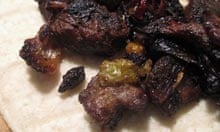
Although striving for "authenticity" with a chilli con carne strikes me as an outrageous betrayal of its rough and ready, mestizo roots, I decide my quest really ought to start with the most basic, stripped-back version of the dish, as might feasibly have been knocked up by generations of cowboys under the stars, and as told to the luminaries of the International Chili Society by a few "old-timers" at a "Texican" bar in Marfa, Texas.
The freshly-killed beef would have been tough, so I use chuck steak, cut up "into pieces about the size of a pecan". It goes into the pot along with suet, salt and "the same amount of wild onions, garlic, oregano and chiles as meat". (In the absence of any wild onions in north London, I use large salad onions.)
This is then cooked until the meat "is as tender as you think it's going to get". It's a recipe simpler than any to grace a jar of sauce, so I'm not expecting much from it, but, although the dish is utterly unlike anything I'd recognise as chili, after two hours, the combination of slightly caramelised beef, chilli, and blackened onions is undeniably delicious on a warm corn tortilla. Those cowboys sure knew what they were doing.
The Chilli Queens
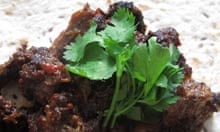
Interesting as this diversion into American history has been, the chilli I seek seems to have arrived on the scene somewhat later, in the company of the Chilli Queens of San Antonio – Mexican women who sold homemade, highly spiced stews from carts "to a cadre of customers who rode in from all over the prairies to singe their tonsils". The cut and thrust of competition between the queens was, the ICS suggests, the making of the dish, as each strove to outdo the others in attracting the hungry punters.
The queens are no more, but the Institute of Texan Cultures has published one of their recipes, "slightly adapted for shopping convenience". I flour chuck steak and pork shoulder, and throw them into a hot pot with an over-generous amount of both dripping and lard. Once they've browned, I add onions and garlic, and while these soften, I'm busy grinding chillies – ancho, serrano and "dried red" ones – which I've tracked all over town, with cumin seeds and Mexican oregano.
I tip this rough powder (the chilli queens sound like pretty rustic cooks) into the pot along with salt and water, and leave it all to simmer for 2 hours. The meat is melting and unctuous, and the spicing surprisingly subtle given the number and variety of peppers involved, but I miss the beans (the recipe explicitly prohibits the addition of frijoles) and it doesn't seem like chilli without mince. Good use of spice, but there's a way to go yet.
The devotee
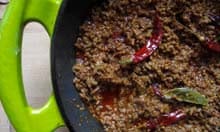
Journalist Joe Cooper was probably the original chillihead, as fans like to refer to themselves. In 1952 he distilled a lifetime devoted "to the study of chilli" as the ICS has it, into the definitive book on the subject (With or Without Beans, available secondhand for $247 on amazon.com), which includes his own recipe ("Maybe not the best ever, but one which satisfies the Coopers' appetites").
I fry lean minced beef over a high heat until grey and with the texture of "whole grain hominy" (at a guess), then add a quart of water and cook at a bubbling simmer for 2 hours. It's not looking terribly promising by the time I stir in the bay leaves, garlic, cumin, oregano, red and black pepper, sugar and paprika, but after half an hour, things are smelling distinctly more familiar – and utterly beguiling.
In goes the thickener – cornmeal in my case, as I have next to no idea what the apparently more convenient cracker meal might be – and a little more water to loosen, and Joe's chilli is ready to serve. It's still a bit dry, and the cornflour has given what sauce there is a slightly grainy texture, but the texture of the meat is a revelation: slow-cooking mince transforms it into something quite, quite wonderful. Still no beans though.
The Spanish
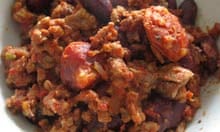
Hugh Fearnley-Whittingstall also has an aversion to good old British "napalm bolognese", and his recipe in the River Cottage Meat Book attempts to "restore some dignity to the dish", even if, as he freely admits, it doesn't aspire to "aboriginal correctness".
As well as mince, he includes pork shoulder and chorizo, plus a cinnamon stick, in an apparent nod to the dish's Mexican heritage. Most notably, however, this, the first British recipe I try, is also the first to include tomatoes, as well as stock: water seems more usual in the dish's homeland.
My flatmate approves of the "lumpy, bumpy texture" that the different meats give the dish, but it's hard to see what the pork shoulder adds here in terms of flavour: in fact, everything, tomatoes, cinnamon and all, just tastes of chorizo. And, much as we all love chorizo, it doesn't seem right in a chilli.
The chocolatey

Nigella is never a lady to leave a lily ungilded, so I barely raise an eyebrow at the cocoa powder in her recipe – after all, chocolate is a key ingredient in Mexican moles, so it's hardly as fanciful as the cardamom pods, an Indian spice which seems to pop up in just about everything she cooks.
The cocoa adds a certain richness to the dish, but any earthiness is knocked on the head by the three kinds of tomato she sticks in there: tinned, pureed and … ketchup. It's a bit boring to be honest, but the fluffy cornbread topping, with its cinnamon and honey, wins much praise among my chilli committee.
Chilli con Jamie

One of the dishes that made a particular impression on me on Jamie's American road trip was his cowboy chilli, which uses brisket, simmered long and very slow in smoky chillies and paprika, muscovado sugar and coffee, until it can be pulled apart with a fork.
The finished stew looks like something from my favourite burrito van, complete with peppers, and I love the campfire flavour of the spices and the coffee, but I'm perplexed by his decision to stick 2 tins of tomatoes in there too – they completely change the character of the dish. After leaving it in the fridge overnight, I get a text the next day from my flatmate's boyfriend asking if it was, in fact, chilli because "it reminded me of pulled pork."
Perfect chilli
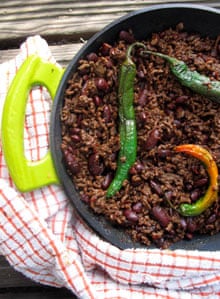
Tradition may frown upon it, but I think chilli works best with minced meat – that yielding texture, reminiscent of wholesome hominy grits, is as much a part of my conception of the dish as the slightly mealy beans that bulk it out.
I'm adding smoky spice and coffee, like Jamie, and a generous level of garlic, as a nod to the basic recipe, but the overall character of my chilli owes much to both the Chilli Queens and James E Cooper, stripped of tomatoes, but heavy on peppers and aromatic oregano. An Anglo-Texican hybrid, if you like – and just the thing for a jacket potato. (NB: the chillies and Mexican oregano are available to order online if you can't find them in the real world.)
Serves 6-8
Beef dripping or vegetable oil, to fry
1kg mince
2 onions, thinly sliced
5 cloves of garlic, minced
500ml freshly brewed coffee
2 chipotle chillies
2 ancho chillies
1 tsp cumin seeds, toasted
1 tbsp Mexican oregano
1 tbsp dark brown muscovado sugar
2 tsp chilli powder, or to taste
2 fresh long green chillies
400g cooked kidney beans
1. Heat the fat in a large, heavy-bottomed pan on a high heat, then brown the mince in batches, stirring regularly: don't crowd the pan, or it will steam rather than brown. Add the onions and stir fry briefly, until slightly browned.
2. Turn the heat down and add the garlic. Stir and cook until the onion has completely softened, then add the coffee and a generous pinch of salt and simmer, covered, for 2 hours.
3. Meanwhile, cut the stalks off the dried chillies and take out the seeds. Grind together in a pestle and mortar with rock salt and the roasted cumin seeds. Stir in the oregano and chilli powder.
4. Add the spices to the pan along with the sugar fresh chillies and simmer, partially covered, for another half hour, adding a little water if it seems dry, or you prefer a saucier chilli. 10 minutes before the end of cooking, add the beans, taste, and adjust the seasoning and spicing if necessary. If possible, leave overnight and reheat to serve.
Does the British version of chilli con carne have its own merits, or is it an affront to one of the southwest's proudest pieces of culinary heritages? Do tomatoes add anything to the dish – and what about the vexed question of beans? And what do you serve it with: rice, tortillas, or a big plate of chips?

Comments (…)
Sign in or create your Guardian account to join the discussion